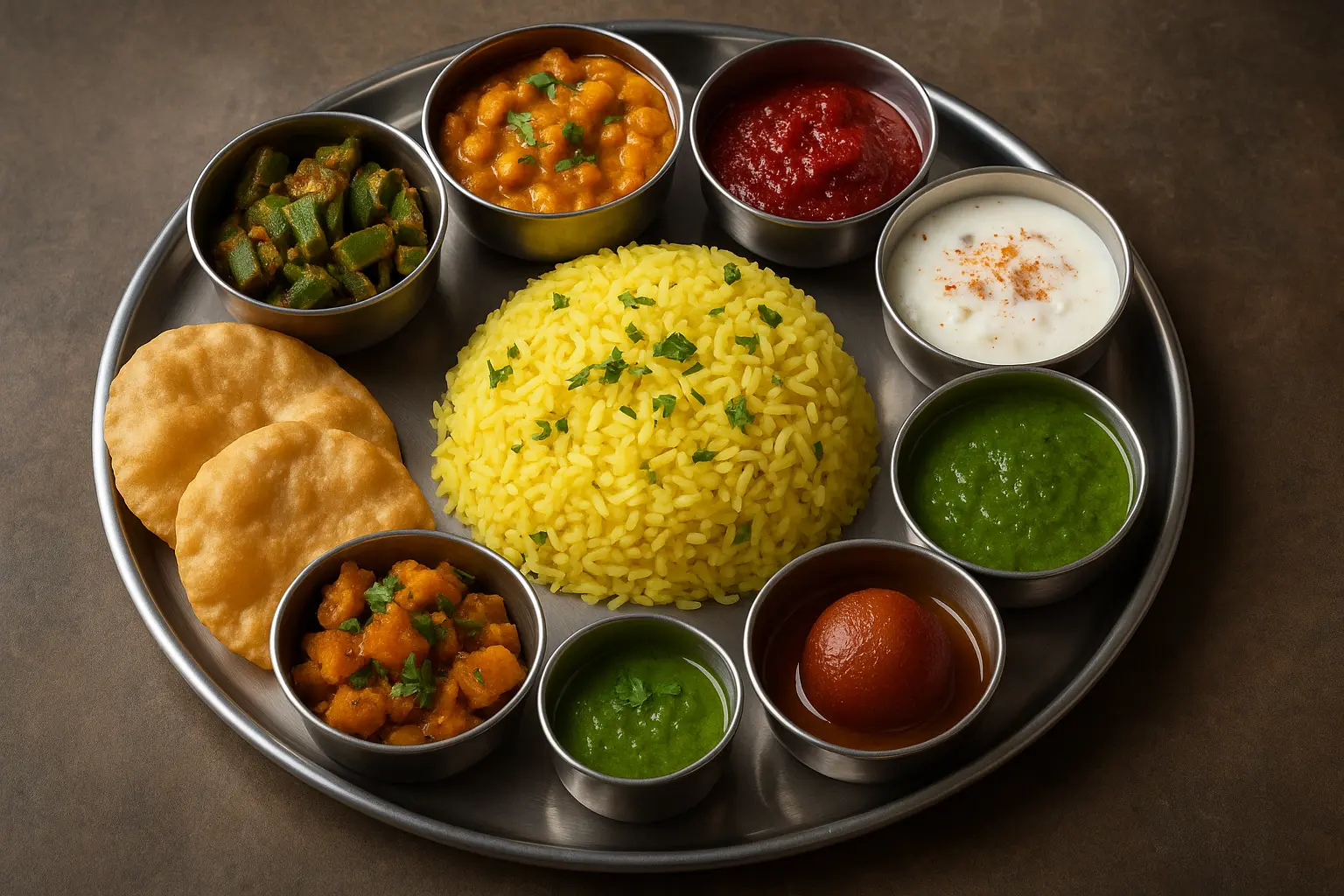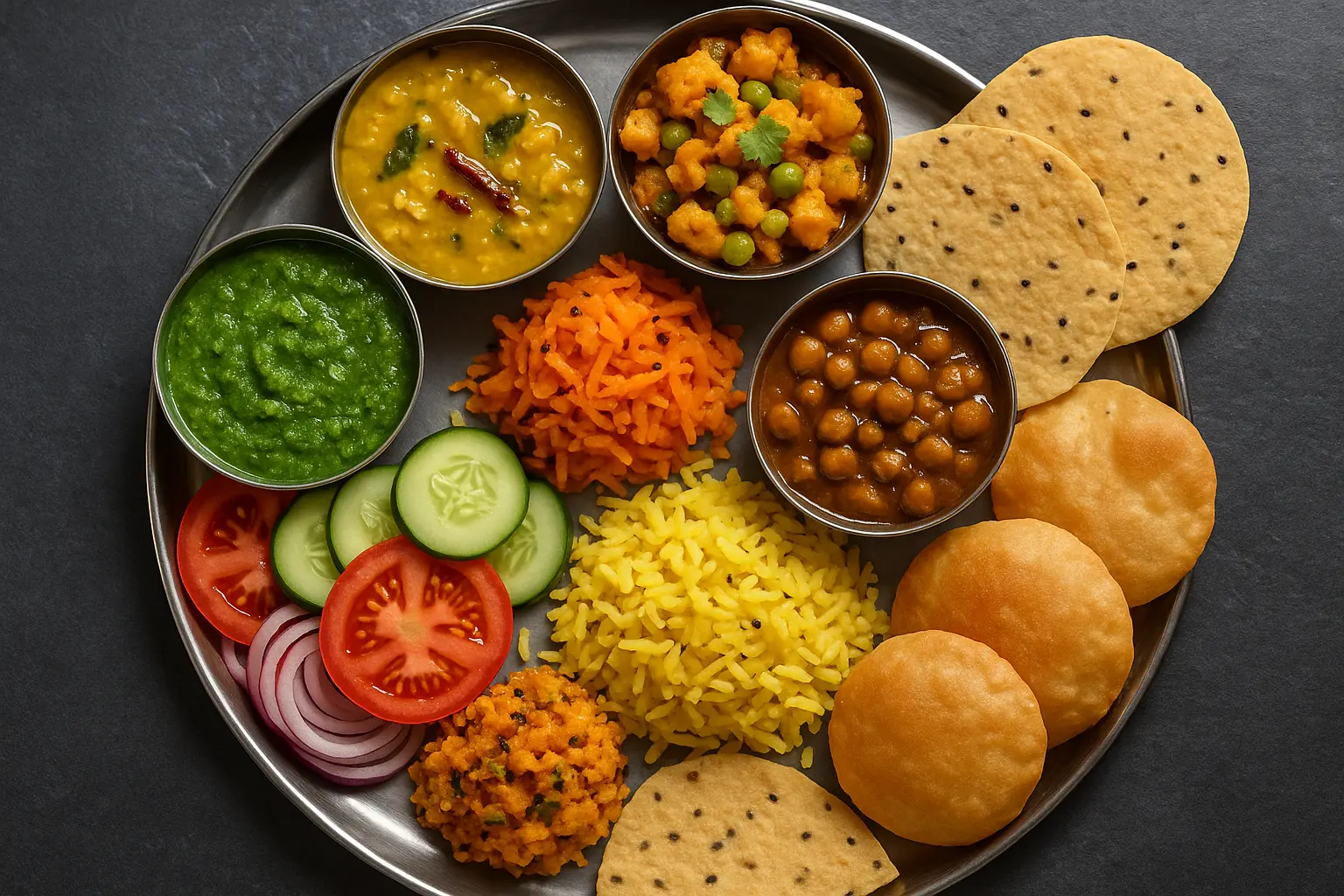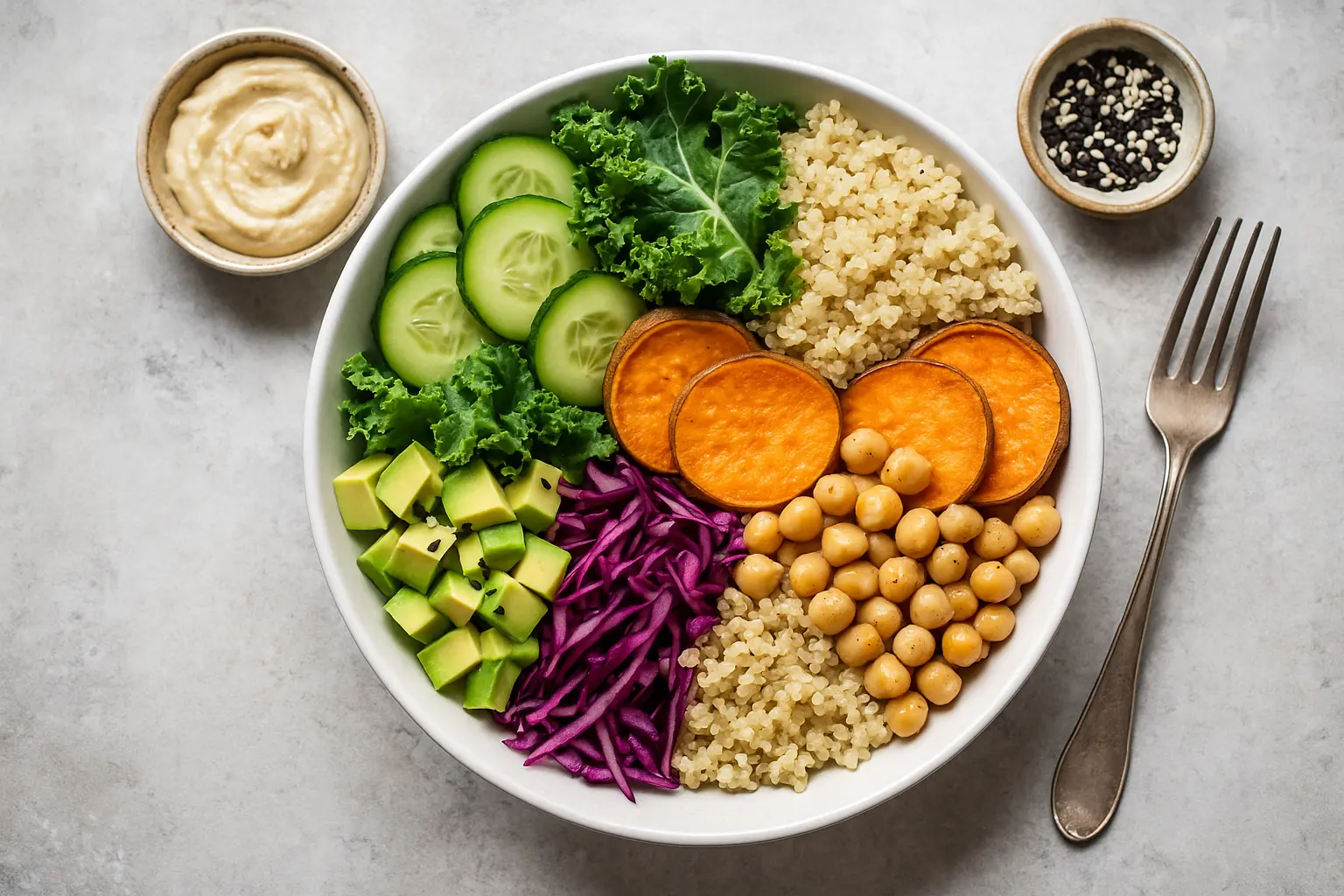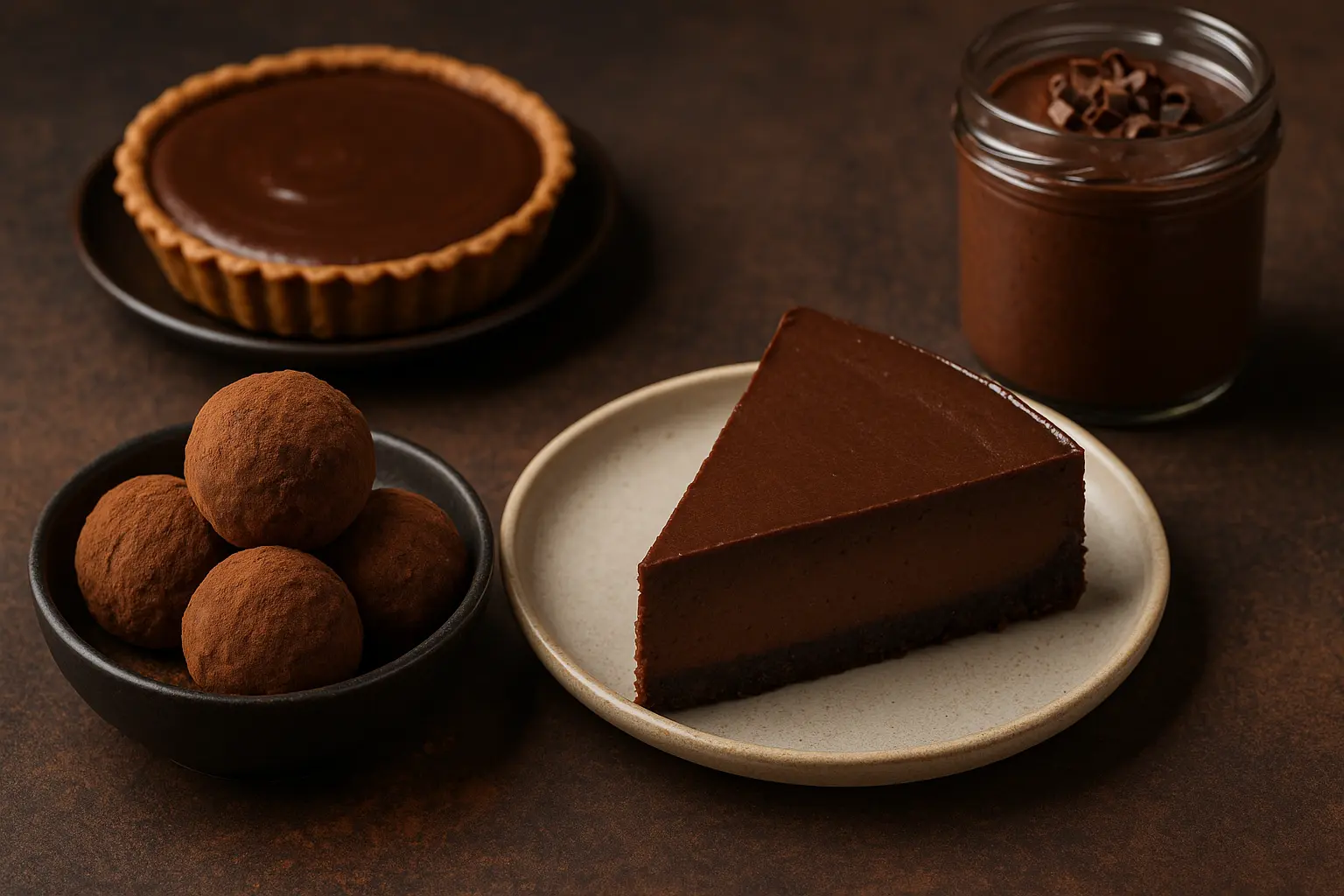If there’s one food concept that truly represents the diversity and balance of Indian cuisine, it is the thali. A thali, literally meaning “plate,” is a curated spread of multiple dishes served together on a large plate. Unlike a single dish meal, a thali embodies variety—different flavors, textures, and nutrients come together in one satisfying platter.
Traditionally, thalis vary region to region. A South Indian thali might include sambar, rasam, curd rice, and papadam, while a Rajasthani thali could have dal baati churma, gatte ki sabzi, and ker sangri. Beyond geography, thalis also adapt to seasons, festivals, and personal dietary choices.
This blog explores creative Indian thali combinations—fresh takes on the traditional format that are versatile, nourishing, and adaptable to vegan and gluten-free lifestyles. Whether you want a weekday meal plan, a festive indulgence, or a special family weekend spread, these thali ideas will inspire your kitchen.

Section 1: The Art of Building a Thali
A great thali isn’t about excess—it’s about balance. Every thali usually covers:
Grain base – rice, millet, roti, puri, or dosa.
Protein element – lentils, beans, paneer, tofu, or meats (for non-vegetarian).
Vegetable sides – dry stir-fries, curries, or salads.
Condiments – chutneys, pickles, papads, or raitas.
Comfort bowl – yogurt, kadhi, or buttermilk for cooling.
Sweet note – a kheer, halwa, or mithai.
When curating creative thali combinations, you can:
Mix regional cuisines.
Use seasonal vegetables and grains.
Incorporate modern diet preferences like vegan, gluten-free, or high-protein.
Add global twists while retaining Indian authenticity.
Section 2: Classic Regional Inspirations to Build Upon
Before we dive into creative combinations, here’s a quick look at some regional thalis that serve as inspiration:
Gujarati Thali: Rotis, dal, kadhi, shaak (vegetables), farsan, rice, chutney, and shrikhand.
South Indian Thali: Sambar, rasam, poriyal (stir-fry), curd rice, pickle, appalam, payasam.
Rajasthani Thali: Dal baati churma, gatte ki sabzi, ker sangri, missi roti, papad, jalebi.
Punjabi Thali: Butter naan, dal makhani, paneer butter masala, rajma, boondi raita, gulab jamun.
Bengali Thali: Shukto (bitter vegetable medley), fish curry or cholar dal, aloo posto, mishti doi, luchis.
These traditional spreads form the canvas for our creative thali experiments.
Section 3: Creative Indian Thali Combinations
1. The Vegan Protein Power Thali
Designed for those seeking plant-based, protein-rich meals.
Base: Quinoa pulao with cumin and peas.
Protein: Tofu tikka masala or masoor dal tadka.
Vegetable sides: Bhindi fry and pumpkin sabzi.
Condiments: Mint-coriander chutney and peanut podi (dry chutney).
Cooling element: Coconut milk raita with cucumber.
Sweet: Vegan almond kheer with jaggery.
This thali is ideal for post-workout dinners or anyone following a vegan lifestyle.
2. Gluten-Free Comfort Thali
Perfect for gluten-free eaters who miss the variety of a roti-based thali.
Base: Jowar or bajra bhakri with ghee (or vegan oil).
Protein: Chana masala or panchmel dal.
Vegetables: Aloo methi sabzi and lauki chana dal curry.
Condiments: Mango pickle and roasted papad.
Cooling: Buttermilk with roasted cumin powder.
Sweet: Coconut laddoo.
This thali is nourishing, filling, and free of wheat-based breads.
3. Ayurvedic Balance Thali
Inspired by Ayurveda, this thali balances the six tastes—sweet, sour, salty, bitter, pungent, and astringent.
Base: Red rice or hand-pounded rice.
Protein: Moong dal khichdi tempered with ghee.
Vegetables: Bitter gourd stir fry, spinach curry, and beetroot pachadi.
Condiments: Fresh ginger pickle, coriander chutney.
Cooling: Spiced buttermilk.
Sweet: Date and sesame ladoo.
This thali is grounding, easy to digest, and perfect for seasonal detox.
4. Festive Fusion Thali
Blends traditional dishes with modern plating for celebrations.
Base: Mini puris or saffron rice.
Protein: Paneer pasanda or rajma galouti kebabs.
Vegetables: Navratan korma and crispy karela chips.
Condiments: Beetroot chutney and apple-ginger pickle.
Cooling: Shrikhand or vegan cashew yogurt with fruit.
Sweet: Rose gulab jamun cheesecake cups.
This thali makes any festival dinner feel extravagant.
5. Budget-Friendly Everyday Thali
Designed for practicality without compromising taste.
Base: Steamed rice and chapati.
Protein: Simple dal fry.
Vegetables: Aloo gobi and tinda sabzi.
Condiments: Green chutney, pickle.
Cooling: Yogurt.
Sweet: Suji halwa.
Great for students, families, or bachelors looking for wholesome yet affordable meals.
6. Street Food Thali
A fun twist for foodies who love Indian street flavors.
Base: Mini pav or millet poha.
Protein: Ragda pattice or chole tikki.
Vegetables: Dahi aloo chaat and corn bhel.
Condiments: Tamarind chutney, mint chutney, sev.
Cooling: Masala chaas.
Sweet: Kulfi falooda shots.
This thali brings the street cart experience home.
7. Winter-Warmer Thali
Loaded with seasonal produce and warming spices.
Base: Bajra rotla with ghee.
Protein: Sarson da saag with a dollop of butter.
Vegetables: Gajar matar sabzi and methi thepla chips.
Condiments: Garlic chutney, jaggery.
Cooling: Not needed—replace with spiced herbal tea.
Sweet: Gajar ka halwa.
Ideal for cold evenings, this thali provides comfort and heat.
8. Monsoon Mood Thali
Perfect for rainy days when cravings run high.
Base: Steamed rice.
Protein: Pakora kadhi.
Vegetables: Bhutta masala (spiced corn) and arbi fry.
Condiments: Green chili pickle, papad.
Cooling: Spiced lassi.
Sweet: Malpua with rabri.
This thali captures the indulgence of rainy-day cravings.
Section 4: Weekly Meal Plan Using Thali Concepts
You can also use the thali structure to create weekly menus. Here’s a sample plan:
Monday: Vegan protein thali with tofu curry, quinoa, pumpkin sabzi.
Tuesday: Gluten-free thali with jowar bhakri, lauki chana dal.
Wednesday: Street food thali for midweek fun.
Thursday: Ayurvedic thali for light digestion.
Friday: Festive fusion thali for weekend vibes.
Saturday: Winter or Monsoon thali based on season.
Sunday: Budget-friendly simple dal-chapati thali.
This rotation keeps meals exciting while ensuring balance.
Section 5: Tips to Curate Your Own Thali
Mix colors – a visually vibrant plate excites the appetite.
Balance flavors – ensure sweet, sour, spicy, and bitter are represented.
Think nutrition – include proteins, fiber, and probiotics.
Portion wisely – small servings of many items prevent waste.
Seasonal eating – use what’s fresh and local.
Conclusion
A thali is more than just food—it’s an experience of abundance, culture, and nourishment. By creating thoughtful combinations, you can adapt this timeless tradition to suit modern lifestyles, dietary needs, and creative experiments. From vegan protein-packed thalis to festive fusion platters, the possibilities are endless.
Next time you plan your weekly meals or host a celebration, try one of these creative Indian thali combinations—your taste buds and your body will thank you.
Leave a comment
Your email address will not be published. Required fields are marked *




















